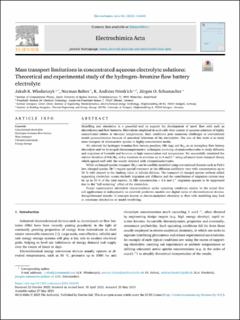Please use this identifier to cite or link to this item:
https://doi.org/10.21256/zhaw-27957Full metadata record
| DC Field | Value | Language |
|---|---|---|
| dc.contributor.author | Wlodarczyk, Jakub | - |
| dc.contributor.author | Baltes, Norman | - |
| dc.contributor.author | Friedrich, K. Andreas | - |
| dc.contributor.author | Schumacher, Jürgen | - |
| dc.date.accessioned | 2023-06-02T06:30:50Z | - |
| dc.date.available | 2023-06-02T06:30:50Z | - |
| dc.date.issued | 2023-05-27 | - |
| dc.identifier.issn | 0013-4686 | de_CH |
| dc.identifier.issn | 1873-3859 | de_CH |
| dc.identifier.uri | https://digitalcollection.zhaw.ch/handle/11475/27957 | - |
| dc.description.abstract | Modelling and simulation is a powerful tool to support the development of novel flow cells such as electrolysers and flow batteries. Electrolytes employed in such cells often consist of aqueous solutions of highly concentrated solutes at elevated temperatures. Such conditions pose numerous challenges in conventional model parametrisation because of non-ideal behaviour of the electrolytes. The aim of this work is to study mass transport of electroactive species in highly-concentrated media. We selected the hydrogen-bromine flow battery posolyte, HBr (aq) and Br2, as an exemplary flow battery electrolyte and we leveraged chronoamperometric techniques involving ultramicroelectrodes to study diffusion and migration of bromide and bromine at high concentration and temperature. We successfully simulated the current densities of HBr/Br2 redox reactions in solutions up to 8 mol L–1 using advanced mass transport theory which agreed well with the results obtained with ultramicroelectrodes. While uncharged species transport (Br2) can be credibly modelled using conventional theories such as Fick’s law, charged species (Br–) require special treatment as the diffusion coefficient vary with concentration up to 50 % with respect to the limiting value at infinite dilution. The transport of charged species without added supporting electrolyte occurs via both migration and diffusion and the contribution of migration current may be up to 50 % of the total current. At HBr concentration 0.6 mol L–1 migration appears to be suppressed due to the “self-screening” effect of the electrolyte. Proper experimental electrolyte characterisation under operating conditions similar to the actual flow cell applications is indispensable to establish predictive models and digital twins of electrochemical devices. Straightforward transfer of concepts known in electro-analytical chemistry to flow cells modelling may lead to erroneous simulations or model overfitting. | de_CH |
| dc.language.iso | en | de_CH |
| dc.publisher | Elsevier | de_CH |
| dc.relation.ispartof | Electrochimica Acta | de_CH |
| dc.rights | http://creativecommons.org/licenses/by/4.0/ | de_CH |
| dc.subject | Concentrated electrolyte | de_CH |
| dc.subject | Hydrogen-bromine flow battery | de_CH |
| dc.subject | Mass transport | de_CH |
| dc.subject | Ultramicroelectrode | de_CH |
| dc.subject | Energy storage | de_CH |
| dc.subject.ddc | 621.3: Elektro-, Kommunikations-, Steuerungs- und Regelungstechnik | de_CH |
| dc.title | Mass transport limitations in concentrated aqueous electrolyte solutions : theoretical and experimental study of the hydrogen-bromine flow battery electrolyte | de_CH |
| dc.type | Beitrag in wissenschaftlicher Zeitschrift | de_CH |
| dcterms.type | Text | de_CH |
| zhaw.departement | School of Engineering | de_CH |
| zhaw.organisationalunit | Institute of Computational Physics (ICP) | de_CH |
| dc.identifier.doi | 10.1016/j.electacta.2023.142640 | de_CH |
| dc.identifier.doi | 10.21256/zhaw-27957 | - |
| zhaw.funding.eu | info:eu-repo/grantAgreement/EC/H2020/765289// European Training Network to improve materials for high-performance, low-cost next- generation redox-flow batteries/FlowCamp | de_CH |
| zhaw.issue | 142640 | de_CH |
| zhaw.originated.zhaw | Yes | de_CH |
| zhaw.publication.status | publishedVersion | de_CH |
| zhaw.volume | 461 | de_CH |
| zhaw.publication.review | Peer review (Publikation) | de_CH |
| zhaw.webfeed | Elektrische Energiesysteme und Smart Grids | de_CH |
| zhaw.funding.zhaw | Redox Flow Battery Campus | de_CH |
| zhaw.author.additional | No | de_CH |
| zhaw.display.portrait | Yes | de_CH |
| Appears in collections: | Publikationen School of Engineering | |
Files in This Item:
| File | Description | Size | Format | |
|---|---|---|---|---|
| 2023_Wlodarczyk-etal_Mass-transport-limitations-concentrated-aqueous-electrolyte-solutions.pdf | 1.42 MB | Adobe PDF |  View/Open |
Show simple item record
Wlodarczyk, J., Baltes, N., Friedrich, K. A., & Schumacher, J. (2023). Mass transport limitations in concentrated aqueous electrolyte solutions : theoretical and experimental study of the hydrogen-bromine flow battery electrolyte. Electrochimica Acta, 461(142640). https://doi.org/10.1016/j.electacta.2023.142640
Wlodarczyk, J. et al. (2023) ‘Mass transport limitations in concentrated aqueous electrolyte solutions : theoretical and experimental study of the hydrogen-bromine flow battery electrolyte’, Electrochimica Acta, 461(142640). Available at: https://doi.org/10.1016/j.electacta.2023.142640.
J. Wlodarczyk, N. Baltes, K. A. Friedrich, and J. Schumacher, “Mass transport limitations in concentrated aqueous electrolyte solutions : theoretical and experimental study of the hydrogen-bromine flow battery electrolyte,” Electrochimica Acta, vol. 461, no. 142640, May 2023, doi: 10.1016/j.electacta.2023.142640.
WLODARCZYK, Jakub, Norman BALTES, K. Andreas FRIEDRICH und Jürgen SCHUMACHER, 2023. Mass transport limitations in concentrated aqueous electrolyte solutions : theoretical and experimental study of the hydrogen-bromine flow battery electrolyte. Electrochimica Acta. 27 Mai 2023. Bd. 461, Nr. 142640. DOI 10.1016/j.electacta.2023.142640
Wlodarczyk, Jakub, Norman Baltes, K. Andreas Friedrich, and Jürgen Schumacher. 2023. “Mass Transport Limitations in Concentrated Aqueous Electrolyte Solutions : Theoretical and Experimental Study of the Hydrogen-Bromine Flow Battery Electrolyte.” Electrochimica Acta 461 (142640). https://doi.org/10.1016/j.electacta.2023.142640.
Wlodarczyk, Jakub, et al. “Mass Transport Limitations in Concentrated Aqueous Electrolyte Solutions : Theoretical and Experimental Study of the Hydrogen-Bromine Flow Battery Electrolyte.” Electrochimica Acta, vol. 461, no. 142640, May 2023, https://doi.org/10.1016/j.electacta.2023.142640.
Items in DSpace are protected by copyright, with all rights reserved, unless otherwise indicated.